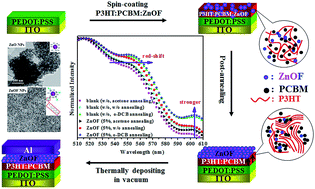Formation of cathode buffer layer by surface segregation of fluoroalkyl-modified ZnO for polymer solar cells
Abstract
Novel zinc oxide nanoparticles (ZnO NPs) modified by silanization using triethoxy-1H,1H,2H,2H-tridecafluoro-n-octylsilane (TTFO), referred to as ZnOF NPs, have been successfully synthesized. Driven by the surface segregation behavior of the fluoroalkyl chains ascribed to their low surface energy, ZnOF NPs can migrate from the blend system with poly(3-hexylthiophene):[6,6]-phenyl-C61-butyric acid methyl ester (P3HT:PCBM) to the surface of the active layer during the annealing process and consequently self-assemble as a cathode buffer layer. The addition of functionalized ZnOF NPs assists in the stacking of the P3HT chains to form a favorable morphology of the active layer with remarkable phase separation, especially upon annealing optimization in o-DCB solvent. The best power conversion efficiency (PCE) of 2.4% is achieved with an open-circuit voltage (Voc) of 0.49 V, short-circuit current density (Jsc) of 8.1 mA cm−2 and fill factor (FF) of 61%, based on the self-assembled cathode buffer layer of ZnOF NPs (5 wt%) upon annealing in o-DCB. Therefore, this novel approach could realize the fabrication of both the active layer and cathode buffer layer through a single step, which not only simplifies the fabrication procedure and reduces the manufacturing cost of polymer solar cells, but also increases the PCE, by reduction of the Schottky barrier at the interface, and the stability of the devices.


 Please wait while we load your content...
Please wait while we load your content...